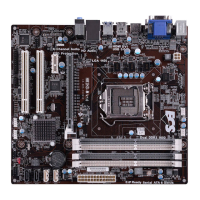
Do you have a question about the ECS H81H3-M and is the answer not in the manual?
| Brand | ECS |
|---|---|
| Model | H81H3-M |
| Category | Motherboard |
| Language | English |
Legal protection for the publication, illustrations, and software.
Information subject to change without notice, no warranties implied.
Acknowledges registered trademarks of Microsoft and Intel.
Compliance statement for Class B digital devices per FCC Rules.
Statement of compliance with relevant FCC and EMC directives.
Outlines the structure and content of the user manual chapters.
Overview of the H81H3-M motherboard, its features and compatibility.
Lists the items included in the motherboard package.
Detailed technical specifications of the motherboard components and interfaces.
Diagram and labeling of the motherboard's physical components and connectors.
Description and connection details for the motherboard's rear input/output ports.
Essential safety guidelines to follow before and during motherboard installation.
Step-by-step guide for physically mounting the motherboard into a computer case.
Instructions for verifying and configuring motherboard jumpers, including CMOS reset.
Detailed steps for correctly installing the CPU into the LGA1150 socket.
Guide for mounting the CPU heatsink and fan assembly.
Instructions for inserting DDR3 RAM modules into the DIMM slots.
How to install expansion cards into PCI and PCI Express slots.
Guidance on connecting various internal and external devices to motherboard headers.
Steps for connecting SATA hard drives to the motherboard.
Connecting front panel connectors, power supply, and fans to the motherboard.
Introduction to the BIOS setup utility and its purpose.
How to access the BIOS setup screen during system startup.
Procedure for clearing CMOS settings and loading default values.
Explanation of keyboard keys used for navigating the BIOS interface.
Overview of major BIOS configuration menus including Main, Advanced, Chipset, M.I.B. III, Boot, Security, and Exit.
Step-by-step guide for downloading and installing a new BIOS version.
Guide for using the DVD-ROM's auto-run feature to install drivers and software.
Alternative method for installing drivers via Windows Explorer if auto-install fails.
Utility descriptions for fan control (eSF), driver updates (eDLU), and BIOS updates (eBLU).
Solutions for common issues encountered when first assembling the PC.
Tips for resolving startup issues that may arise after extended PC usage.
Recommended practices for maintaining and caring for the motherboard.
A visual guide to diagnose and resolve common PC startup and operation issues.
